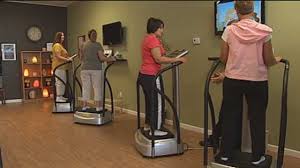Vibration therapy studies
Vibration therapy studies have been conducted for over 10 years. In this kind of therapy a person stands on a platform that vibrates rapidly so that their whole body does also. Proponents of this therapy claim that the rapid vibration induces stress on the bones and that the Osteoblast cells (bone building cells) respond with greater activity - this increasing bone density.
Critics of vibration therapy state the whole body vibration is a health risk for many persons with chronic conditions such as cardiovascular disease and that if this therapy used too often or too long, it can also cause damage to the spine.
What is vibration therapy?
There are several commercial models of machines that will vibrate your body. Some are used for physiotherapy; others for training.
The physiotherapy whole body vibration includes stretches and/or massages while you are in light contact with the machine. The most frequent position is to stand upright, lock-legged on a pivotal or low energy lineal machine.
Those who use body vibration machines for work out training, assume various positions while on the machine - thus exercising specific muscles.
It is the first of these, standing on a vibrating machine that has been advocated by some for increasing bone density.

Vibration therapy studies: outcomes
2010 Effect of whole-body vibration on BMD: a systematic review and meta-analysis. Osteoporosis International. April 201. by L. Slaskovska, S.M.H. Alibhai, J. Beyene and A. M. Cheung.
Here is a summary of the firstVibration therapy studies I found. Summary: "Our systematic review and meta-analysis of randomized controlled trials (RCTs) examining whole-body vibration (WBV) effect on bone mineral density (BMD) found significant but small improvements in hip areal BMD (aBMD) in postmenopausal women and in tibia and spine volumetric BMD in children/adolescents, but not in other BMD measurements in postmenopausal women and young adults."
In 2013, three researchers from Stonybrook University (M. Ete Chan, Gunes Uzer, and Clinton T. Rubin) published a study documenting both positive and negatives effects of vibration therapy. Among the positive outcomes for potential bone building was that "Exceedingly low magnitude mechanical signals, delivered using low intensity vibration (less than 1 g) may ultimately represent a safe and effective non-drug-based strategy for the treatment of osteoporosis"
At the same time these researchers state that " high intensity vibration (greater than 1g) can cause permanent damage to a range of physiologic systems, and must be avoided, particularly in the elderly, injured or infirm."
At last we may have an understanding of why for so long, researchers disagreed so strongly about the potential effectiveness and/or dangers of whole body vibration therapy for persons hoping to increase bone density.
You can read the article published by the Stonybrook University researchers here . Just click on: Potential Danger Vibration Therapy (The article is in pdf format)
Given the mixed reviews by researchers, I hope that you will consult with your health care provider before trying this from of exercise to improve your bone density ....especially if you have any other medical condition.
End of vibration therapy studies.
If you have used vibration therapy as part of your bone building program, I invite you to share your experience with other readers. Just fill in the form below AND BE SURE to copy the url from the top of this page and add it to your comments. That url will let me know where to place your comments. Thanks.
Write a Review
Readers like to read reviews from other readers. Can you do a review?
